List of birds of Ireland
The avifauna of the Republic of Ireland included a total of 485 species as of the end of 2019 according to the Irish Rare Birds Committee (IRBC).[1] Of them, 183 are rare, and 14 of the rarities have not been seen in Ireland since 1950. Three species were either introduced to Ireland or came to Ireland from another introduced population.
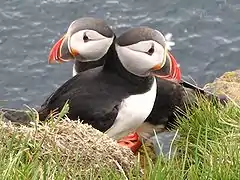

Ireland has a relatively low diversity of breeding birds due to its isolation. Several species such as the tawny owl, Eurasian nuthatch and willow tit which breed in Great Britain have not been recorded. However, there are large colonies of seabirds including important populations of European storm-petrels, northern gannets, and roseate terns. Other notable breeding birds include corn crakes and red-billed choughs. There are no endemic species but there are endemic subspecies of white-throated dipper, coal tit, and Eurasian jay.
Large numbers of wildfowl and waders winter in Ireland, attracted by its mild climate. About half the world population of the Greenland race of greater white-fronted geese spend the winter there. During autumn, many migrating seabirds can be seen off the coasts including several species of skuas, shearwaters, and petrels. Ireland's westerly position means that North American birds are regularly recorded in autumn.
This list's taxonomic treatment (designation and sequence of orders, families and species) and nomenclature (English and scientific names) are those of the International Ornithological Congress (IOC) as of July 2020.[2] Many of the Irish names are taken from the National Terminology Database for Irish.[3]
The following A, B, and C tags are used by the IRBC to define the status of species. "R" is used here for rare species. The list does not include species placed in "Category D" by the IBRC. These are species where there is doubt as to whether they have occurred in a wild state (Category D1), they have arrived by human assistance such as on board a ship (D2), they have only been recorded dead on the tideline (D3), or they are feral species whose populations may not be self-sustaining (D4). Some species have records of individuals in more than one category; the "highest" category is listed here in those cases.
- A - "Species that have been recorded in an apparently natural state in Ireland at least once since 1st January 1950."
- B - "Species that have been recorded in an apparently natural state in Ireland at least once up to 31st December 1949, but have not been recorded subsequently."
- C - "Species that, although originally introduced by man, have established feral breeding populations in Ireland which apparently maintain themselves without necessary recourse to further introduction [and species] that have occurred, but are considered to have originated from established naturalised populations outside Ireland."
- R - Species on IRBC Appendix 1, those "requiring substantiating details", i.e. rarities.
Pheasants and allies
.jpg.webp)
Order: Galliformes Family: Phasianidae
The Phasianidae are a family of terrestrial birds which consists of quails, partridges, snowcocks, francolins, spurfowls, tragopans, monals, pheasants, peafowls, and jungle fowls. In general, they are plump (although they vary in size) and have broad, relatively short wings.
| Common name | Binomial | Irish name | Status |
|---|---|---|---|
| Western capercaillie | Tetrao urogallus | Capall coille | B |
| Willow ptarmigan | Lagopus lagopus | Tarmachan | A |
| Grey partridge | Perdix perdix | Cearc coille | A |
| Common quail | Coturnix coturnix | Gearg / gearraghuirt | A |
| Common pheasant | Phasianus colchicus | Feasán mhuinceach | C |
Ducks, geese, swans
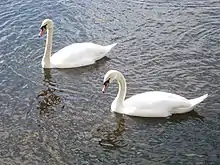

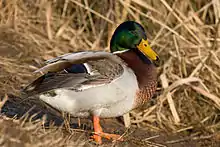
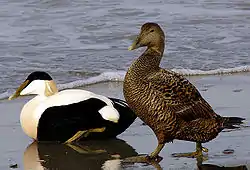
Order: Anseriformes Family: Anatidae
Anatidae includes the ducks and most duck-like waterfowl, such as geese and swans. These birds are adapted to an aquatic existence with webbed feet, flattened bills, and feathers that are excellent at shedding water due to an oily coating.
| Common name | Binomial | Irish name | Status |
|---|---|---|---|
| Brant goose | Branta bernicla | Cadhan | A |
| Red-breasted goose | Branta ruficollis | Gé broinnrua | A R |
| Canada goose | Branta canadensis | Gé cheanadach | A R |
| Barnacle goose | Branta leucopsis | Gé ghiúrainn / cadhan | A |
| Cackling goose | Branta hutchinsii | Brioscarnach-ghé | A R |
| Snow goose | Anser caerulescens | Gé shneachta | A |
| Greylag goose | Anser anser | Crann-ghé / gé mhór fhionn / gé ghlas | A |
| Taiga bean-goose | Anser fabalis | Síolghé taigaí | A |
| Pink-footed goose | Anser brachyrhynchus | Gé ghobghearr | A |
| Tundra bean-goose | Anser serrirostris | Síolghé tundraí | A R |
| Greater white-fronted goose | Anser albifrons | Gé bhánéadanach mhór | A |
| Lesser white-fronted goose | Anser erythropus | Mionghé bhánéadanach / gé bheag fhionn | A R |
| Mute swan | Cygnus olor | Eala bhalbh | A |
| Tundra swan | Cygnus columbianus | Eala thundra | A R |
| Whooper swan | Cygnus cygnus | Eala ghlórach | A |
| Common shelduck | Tadorna tadorna | Seil-lacha | A |
| Ruddy shelduck | Tadorna ferruginea | Seil-lacha rua / garg ruadh | B |
| Mandarin duck | Aix galericulata | Lacha mhandarin | C |
| Baikal teal | Sibirionetta formosa | Praslacha bhaicalach | A R |
| Garganey | Spatula querquedula | Praslacha shamraidh | A |
| Blue-winged teal | Spatula discors | Praslacha ghormeiteach | A |
| Northern shoveler | Spatula clypeata | Slapaire tuaisceartach | A |
| Gadwall | Mareca strepera | Gadual | A |
| Eurasian wigeon | Mareca penelope | Rualacha | A |
| American wigeon | Mareca americana | Rualacha mhericeánach | A |
| Mallard | Anas platyrhynchos | Mallard[4] | A |
| American black duck | Anas rubripes | Lacha chosrua | A R |
| Northern pintail | Anas acuta | Biorearrach tuaisceartach | A |
| Eurasian teal | Anas crecca | Praslacha ghlaseiteach | A |
| Green-winged teal | Anas carolinensis | A | |
| Red-crested pochard | Netta rufina | Póiseard cíordhearg | A |
| Redhead | Aythya americana | Ceanndearg | A R |
| Common pochard | Aythya ferina | Póiseard cíordhearg / lacha mhásach | A |
| Ferruginous duck | Aythya nyroca | Póiseard ferruginous | A R |
| Ring-necked duck | Aythya collaris | Lacha mhuinceach | A |
| Tufted duck | Aythya fuligula | Lacha bhadánach | A |
| Greater scaup | Aythya marila | Lacha iascán mór | A |
| Lesser scaup | Aythya affinis | Mionlacha iascán | A R |
| King eider | Somateria spectabilis | Éadar taibhseach / rígh éadar | A |
| Common eider | Somateria mollissima | Éadar | A |
| Surf scoter | Melanitta perspicillata | Scótar toinne | A |
| Velvet scoter | Melanitta fusca | Sceadach | A |
| White-winged scoter | Melanitta deglandi | Scótarach bháneiteach | A R |
| Common scoter | Melanitta nigra | Scótar / lacha scótarach | A |
| Black scoter | Melanitta americana | Scótar dubh | A R |
| Long-tailed duck | Clangula hyemalis | Lacha earrfhada | A |
| Bufflehead | Bucephala albeola | Órshúileach ceannsceadach | A R |
| Common goldeneye | Bucephala clangula | Órshúileach | A |
| Barrow's goldeneye | Bucephala islandica | Órshúileach bhearú | A R |
| Smew | Mergellus albellus | Síolta gheal | A |
| Hooded merganser | Lophodytes cucullatus | Síolta chochaill | A R |
| Common merganser | Mergus merganser | Síolta / tumaire | A |
| Red-breasted merganser | Mergus serrator | Síolta rua | A |
| Ruddy duck | Oxyura jamaicensis | Lachra rua | C |
Nightjars
Order: Caprimulgiformes Family: Caprimulgidae
Nightjars are medium-sized nocturnal birds that usually nest on the ground. They have long wings, short legs, and very short bills. Most have small feet, of little use for walking, and long pointed wings. Their soft plumage is camouflaged to resemble bark or leaves.
| Common name | Binomial | Irish name | Status |
|---|---|---|---|
| European nightjar | Caprimulgus europaeus | Tuirne lín | A |
| Common nighthawk | Chordeiles minor | Seabhac oidhche | A R |
Swifts
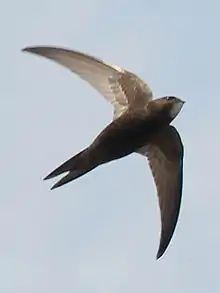
Order: Apodiformes Family: Apodidae
Swifts are small birds which spend the majority of their lives flying. These birds have very short legs and never settle voluntarily on the ground, perching instead only on vertical surfaces. Many swifts have long swept-back wings which resemble a crescent or boomerang.
| Common name | Binomial | Irish name | Status |
|---|---|---|---|
| White-throated needletail | Hirundapus caudacutus | Gabhlán earrspíonach | A R |
| Chimney swift | Chaetura pelagica | Gabhlán simléir | A R |
| Alpine swift | Tachymarptis melba | Gabhlán alpach | A |
| Common swift | Apus apus | Gabhlán gaoithe | A |
| Pallid swift | Apus pallidus | Gabhlán bánlíoch | A R |
| Little swift | Apus affinis | Gabhlán beag | A R |
Bustards
Order: Otidiformes Family: Otididae
Bustards are large terrestrial birds mainly associated with dry open country and steppes in the Old World. They are omnivorous and nest on the ground. They walk steadily on strong legs and big toes, pecking for food as they go. They have long broad wings with "fingered" wingtips and striking patterns in flight. Many have interesting mating displays.
| Common name | Binomial | Irish name | Status |
|---|---|---|---|
| Great bustard | Otis tarda | Fadálach éan-mhór | B R |
| Little bustard | Tetrax tetrax | Fadálach mion-éan | B R |
Cuckoos
_by_Tim_Peukert.jpg.webp)
Order: Cuculiformes Family: Cuculidae
The family Cuculidae includes cuckoos, roadrunners, and anis. These birds are of variable size with slender bodies, long tails, and strong legs. The Old World cuckoos are brood parasites.
| Common name | Binomial | Irish name | Status |
|---|---|---|---|
| Great spotted cuckoo | Clamator glandarius | Mórchuach bhreac | A |
| Yellow-billed cuckoo | Coccyzus americanus | Cuach ghob-bhuí | A R |
| Black-billed cuckoo | Coccyzus erythropthalmus | Cuach bhobdhubh | B R |
| Common cuckoo | Cuculus canorus | Cuach | A |
Sandgrouse
Order: Pterocliformes Family: Pteroclidae
Sandgrouse have small, pigeon-like heads and necks, but sturdy compact bodies. They have long pointed wings and sometimes tails and a fast direct flight. Flocks fly to watering holes at dawn and dusk. Their legs are feathered down to the toes.
| Common name | Binomial | Irish name | Status |
|---|---|---|---|
| Pallas's sandgrouse | Syrrhaptes paradoxus | Gaineamhchearc | A R |
Pigeons and doves

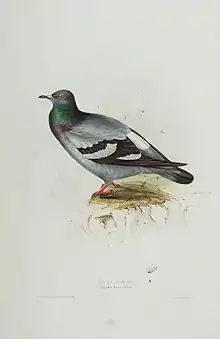
Order: Columbiformes Family: Columbidae
Pigeons and doves are stout-bodied birds with short necks and short slender bills with a fleshy cere.
| Common name | Binomial | Irish name | Status |
|---|---|---|---|
| Rock dove | Columba livia | Colm aille | A |
| Stock dove | Columba oenas | Colm gorm | A |
| Common wood pigeon | Columba palumbus | Colm coille | A |
| European turtle dove | Streptopelia turtur | Fearán | A |
| Eurasian collared dove | Streptopelia decaocto | Fearán baicdhubh | A |
| Mourning dove | Zenaida macroura | Fearán gubhach | A R |
Rails, crakes and coots

Order: Gruiformes Family: Rallidae
Rallidae is a large family of small to medium-sized birds which includes the rails, crakes, coots, and gallinules. Typically they inhabit dense vegetation in damp environments near lakes, swamps, or rivers. In general they are shy and secretive birds, making them difficult to observe. Most species have strong legs and long toes which are well adapted to soft uneven surfaces. They tend to have short, rounded wings and to be weak fliers.
| Common name | Binomial | Irish name | Status |
|---|---|---|---|
| Water rail | Rallus aquaticus | Rálóg uisce / tradhna uisce | A |
| Corn crake | Crex crex | Traonach | A |
| Sora | Porzana carolina | Gearr sora | A R |
| Spotted crake | Porzana porzana | Gearr breac | A |
| Common moorhen | Gallinula chloropus | Cearc uisce / truisc / coileach fraoich | A |
| Eurasian coot | Fulica atra | Cearc cheannann | A |
| American coot | Fulica americana | Cearc mheiriceánach | A R |
| Purple gallinule | Porphyrio martinica | Cearcóg | A R |
| Baillon's crake | Zapornia pusilla | Gearr biorra | A R |
| Little crake | Zapornia parva | Gearr beag | B R |
Cranes
Order: Gruiformes Family: Gruidae
Cranes are large, long-legged, and long-necked birds. Unlike the similar-looking but unrelated herons, cranes fly with necks outstretched, not pulled back. Most have elaborate and noisy courting displays or "dances".
| Common name | Binomial | Irish name | Status |
|---|---|---|---|
| Sandhill crane | Antiogne canadensis | Corr ceanadach | B R |
| Common crane | Grus grus | Corr / grús | A |
Grebes
.jpg.webp)
Order: Podicipediformes Family: Podicipedidae
Grebes are small to medium-large freshwater diving birds. They have lobed toes and are excellent swimmers and divers. However, they have their feet placed far back on the body, making them quite ungainly on land.
| Common name | Binomial | Irish name | Status |
|---|---|---|---|
| Little grebe | Tachybaptus ruficollis | Spágaire tonn / tomaire beag | A |
| Pied-billed grebe | Podilymbus podiceps | Foithíoch gob-alabhreac | A R |
| Red-necked grebe | Podiceps grisegena | Foitheach píbrua | A |
| Great crested grebe | Podiceps cristatus | Foitheach mór / Lúnadán mór an chorraicín | A |
| Horned grebe | Podiceps auritus | Beann-foitheach | A |
| Black-necked grebe | Podiceps nigricollis | Foithíoch cluasach | A |
Stone-curlews, thick-knees
Order: Charadriiformes Family: Burhinidae
The thick-knees are a group of waders found worldwide within the tropical zone, with some species also breeding in temperate Europe and Australia. They are medium to large waders with strong black or yellow-black bills, large yellow eyes, and cryptic plumage. Despite being classed as waders, most species have a preference for arid or semi-arid habitats.
| Common name | Binomial | Irish name | Status |
|---|---|---|---|
| Eurasian stone-curlew | Burhinus oedicnemus | Glúinramhrach caoirliun | A R |
Oystercatchers
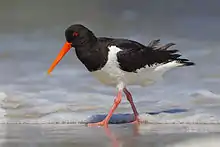
Order: Charadriiformes Family: Haematopodidae
The oystercatchers are large and noisy plover-like birds, with strong bills used for smashing or prising open molluscs.
| Common name | Binomial | Irish name | Status |
|---|---|---|---|
| Eurasian oystercatcher | Haematopus ostralegus | Roilleach / riabhán / scaladóir | A |
Stilts, avocets
Order: Charadriiformes Family: Recurvirostridae
Recurvirostridae is a family of large wading birds which includes the avocets and stilts. The avocets have long legs and long up-curved bills. The stilts have extremely long legs and long, thin, straight bills.
| Common name | Binomial | Irish name | Status |
|---|---|---|---|
| Black-winged stilt | Himantopus himantopus | Scodlach dubheiteach | A |
| Pied avocet | Recurvirostra avosetta | Abhóiséad breac | A |
Plovers


_(11).jpg.webp)
Order: Charadriiformes Family: Charadriidae
The family Charadriidae includes the plovers, dotterels, and lapwings. They are small to medium-sized birds with compact bodies, short thick necks, and long, usually pointed, wings. They are found in open country worldwide, mostly in habitats near water.
| Common name | Binomial | Irish name | Status |
|---|---|---|---|
| Northern lapwing | Vanellus vanellus | Saotharcán Tuaisceartach | A |
| Sociable lapwing | Vanellus gregarius | Saotharcóg / pilibín | A R |
| European golden plover | Pluvialis apricaria | Feadóg bhuí / fideog | A |
| American golden plover | Pluvialis dominica | Feadó bhuí mhericeánach | A |
| Pacific golden plover | Pluvialis fulva | Feadóg bhuí Áiseach | A R |
| Grey plover | Pluvialis squatarola | Feadóg bolgdubh | A |
| Common ringed plover | Charadrius hiaticula | Feadóg chladaigh / feadóg an fháinne / ladhrán | A |
| Semipalmated plover | Charadrius semipalmatus | Gobadáinín mionbhosach | A R |
| Little ringed plover | Charadrius dubius | Feadóg an fháinne beag | A |
| Killdeer | Charadrius vociferus | Feadóg ghlórach | A |
| Kentish plover | Charadrius alexandrinus | Feadóigín chosdubh | A R |
| Lesser sand plover | Charadrius mongolus | Feadóg mhara beag | A R |
| Greater sand plover | Charadrius leschenaultii | Feadóg mhara mhór | A |
| Eurasian dotterel | Charadrius morinellus | Amadán móinteach | A |
Sandpipers, snipes

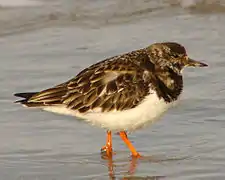

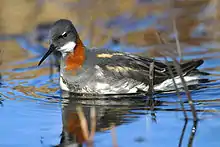
Order: Charadriiformes Family: Scolopacidae
Scolopacidae is a large diverse family of small to medium-sized shorebirds including the sandpipers, curlews, godwits, shanks, tattlers, woodcocks, snipes, dowitchers, and phalaropes. The majority of these species eat small invertebrates picked out of the mud or soil. Variation in length of legs and bills enables multiple species to feed in the same habitat, particularly on the coast, without direct competition for food.
| Common name | Binomial | Irish name | Status |
|---|---|---|---|
| Upland sandpiper | Bartramia longicauda | Gobadán sléibhe | A R |
| Eurasian whimbrel | Numenius phaeopus | Crotach eanaigh | A |
| Eskimo curlew | Numenius borealis | Crotach Artach | B |
| Eurasian curlew | Numenius arquata | Crotach / cruiteach | A |
| Bar-tailed godwit | Limosa lapponica | Guibneach stríocearrach | A |
| Black-tailed godwit | Limosa limosa | Guilbneach earrdubh | A |
| Hudsonian godwit | Limosa haemastica | Guilbneach brionn dearg | A R |
| Ruddy turnstone | Arenaria interpres | Piadálai trá ruadh | A |
| Great knot | Calidris tenuirostris | Cnota mór | A R |
| Red knot | Calidris canutus | Cnota rua | A |
| Ruff | Calidris pugnax | Rufachán | A |
| Broad-billed sandpiper | Calidris falcinellus | Gobadán gobleathan | A |
| Sharp-tailed sandpiper | Calidris acuminata | Gobadán earr-rinneach | A R |
| Stilt sandpiper | Calidris himantopus | Gobadán scodlach | A R |
| Curlew sandpiper | Calidris ferruginea | Gobadán crotaigh | A |
| Temminck's stint | Calidris temminckii | Gobadáinín tomaltaig | A |
| Long-toed stint | Calidris subminuta | Gobadáinín ladharfhada | A R |
| Red-necked stint | Calidris ruficollis | Gobadán droimrua | A R |
| Sanderling | Calidris alba | Luathrán | A |
| Dunlin | Calidris alpina | Breacó | A |
| Purple sandpiper | Calidris maritima | Gobadan cosbhuí | A |
| Baird's sandpiper | Calidris bairdii | Gobadán bárd | A |
| Little stint | Calidris minuta | Gobadáinín beag | A |
| Least sandpiper | Calidris minutilla | Gobadáinín bídeach | A R |
| White-rumped sandpiper | Calidris fuscicollis | Gobadán bánphrompach / gobadán tónbháin | A |
| Buff-breasted sandpiper | Calidris subruficollis | Gobadán broinn-donnbhuí | A |
| Pectoral sandpiper | Calidris melanotos | Gobadán uchtach | A |
| Semipalmated sandpiper | Calidris pusilla | Gobadán mionbhosach | A |
| Western sandpiper | Calidris mauri | Gobadán iartharach | A R |
| Long-billed dowitcher | Limnodromus scolopaceus | Guilbnín gobfhada | A |
| Short-billed dowitcher | Limnodromus griseus | Guilbnín gobghearr | A R |
| Eurasian woodcock | Scolopax rusticola | Creabhar | A |
| Jack snipe | Lymnocryptes minimus | Naoscach bhídeach | A |
| Great snipe | Gallinago media | Naoscach mór | A R |
| Common snipe | Gallinago gallinago | Naoscach | A |
| Wilson's snipe | Gallinago delicata | Naoscach macliam | A R |
| Terek sandpiper | Xenus cinereus | Bodairlín lusrachán | A R |
| Wilson's phalarope | Phalaropus tricolor | Falaróp macliam | A |
| Red-necked phalarope | Phalaropus lobatus | Falaróp gobchaol | A |
| Red phalarope | Phalaropus fulicarius | Falaróp rua | A |
| Common sandpiper | Actitis hypoleucos | Gobadán coiteann | A |
| Spotted sandpiper | Actitis macularia | Gobadán breac | A R |
| Green sandpiper | Tringa ochropus | Gobadán glas | A |
| Solitary sandpiper | Tringa solitaria | Gobadán aonarach | A R |
| Lesser yellowlegs | Tringa flavipes | Mionladhrán buí | A |
| Common redshank | Tringa totanus | Cosdeargán | A |
| Marsh sandpiper | Tringa stagnatilis | Gobadán corraigh | A R |
| Wood sandpiper | Tringa glareola | Gobadán coille | A |
| Spotted redshank | Tringa erythropus | Cosdeargán breac | A |
| Common greenshank | Tringa nebularia | Ladhrán glas | A |
| Greater yellowlegs | Tringa melanoleuca | Ladhrán buí | A R |
Coursers, pratincoles
Order: Charadriiformes Family: Glareolidae
Glareolidae is a family of wading birds comprising the pratincoles, which have short legs, long pointed wings, and long forked tails, and the coursers, which have long legs, short wings, and long, pointed bills which curve downwards.
| Common name | Binomial | Irish name | Status |
|---|---|---|---|
| Cream-colored courser | Cursorius cursor | Rásaí bánbhuí | A R |
| Collared pratincole | Glareola pratincola | Pratancól muinceach | A R |
| Black-winged pratincole | Glareola nordmanni | Pratancól dubheiteach | A R |
Gulls, terns, skimmers
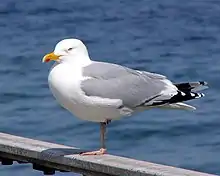

Order: Charadriiformes Family: Laridae
Laridae is a family of medium to large seabirds, the gulls, terns, and skimmers. Gulls are typically grey or white, often with black markings on the head or wings. They have stout, longish bills and webbed feet. Terns are a group of generally medium to large seabirds typically with grey or white plumage, often with black markings on the head. Most terns hunt fish by diving but some pick insects off the surface of fresh water. Terns are generally long-lived birds, with several species known to live in excess of 30 years.
| Common name | Binomial | Irish name | Status |
|---|---|---|---|
| Black-legged kittiwake | Rissa tridactyla | Saidhbhéar | A |
| Ivory gull | Pagophila eburnea | Faoileán eabhartha | A R |
| Sabine's gull | Xema sabini | Sléibhín Sabine | A |
| Bonaparte's gull | Chroicocephalus philadelphia | Sléibhín Bonaparte | A |
| Black-headed gull | Chroicocephalus ridibundus | Sléibhín | A |
| Little gull | Hydrocoloeus minutus | Sléibhín beag | A |
| Ross's gull | Rhodostethia rosea | Faoileán Ross | A |
| Laughing gull | Leucophaeus atricilla | Sléibhín an gháire | A |
| Franklin's gull | Leucophaeus pipixcan | Sléibhín Franklin | A R |
| Mediterranean gull | Ichthyaetus melanocephalus | Sléibhín meánmhuirí | A |
| Mew gull | Larus canus | Faoileán bán | A |
| Ring-billed gull | Larus delawarensis | Faoileán bandghobach | A |
| Great black-backed gull | Larus marinus | Droimneach mór | A |
| Glaucous-winged gull | Larus glaucescens | Faoileán glas | A |
| Glaucous gull | Larus hyperboreus | Faoileán glas | A |
| Iceland gull | Larus glaucoides | Faoileán Íoslannach | A |
| European herring gull | Larus argentatus | Faoileán scadán | A |
| American herring gull | Larus smithsonianus | A | |
| Vega gull | Larus vegae | A | |
| Caspian gull | Larus cachinnans | Faoileán gáiriteach | A R |
| Yellow-legged gull | Larus michahellis | Faoileán scadán cosbhuí | A |
| Slaty-backed gull | Larus schistisagus | A R | |
| Lesser black-backed gull | Larus fuscus | Droimneach beag | A |
| Gull-billed tern | Gelochelidon nilotica | Geabhróg ghobdhubh | A R |
| Caspian tern | Hydroprogne caspia | Geabhróg Chaispeach | A R |
| Royal tern | Thalasseus maximus | Geabhróg ríoga | A R |
| Lesser crested tern | Thalasseus bengalensis | Miongheabhróg chíorach | A R |
| Sandwich tern | Thalasseus sandvicensis | Geabhróg scothdhubh | A |
| Elegant tern | Thalasseus elegans | Geabhróg ghalánta | A R |
| Little tern | Sternula albifrons | Geabhróg bheag | A |
| Sooty tern | Onychoprion fuscatus | Geabhróg shúicheach | A R |
| Roseate tern | Sterna dougallii | Geabhróg rosach | A |
| Common tern | Sterna hirundo | Geabhróg | A |
| Arctic tern | Sterna paradisaea | Geabhróg Artach | A |
| Forster's tern | Sterna forsteri | Geabhróg Forster | A |
| Whiskered tern | Chlidonias hybridus | Geabhróg bhroinndubh | A |
| White-winged tern | Chlidonias leucopterus | Geabhróg bháneiteach | A |
| Black tern | Chlidonias niger | Geabhróg dhubh | A |
Skuas
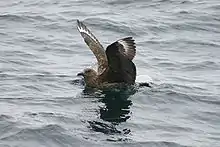
Order: Charadriiformes Family: Stercorariidae
The family Stercorariidae are, in general, medium to large birds, typically with grey or brown plumage, often with white markings on the wings. They nest on the ground in temperate and arctic regions and are long-distance migrants.
| Common name | Binomial | Irish name | Status |
|---|---|---|---|
| Great skua | Stercorarius skua | Meirleach mór | A |
| Pomarine jaeger | Stercorarius pomarinus | Meirleach pomairíneach | A |
| Parasitic jaeger | Stercorarius parasiticus | Meirleach Artach | A |
| Long-tailed jaeger | Stercorarius longicaudus | Meirleach earrfhada | A |
Auks
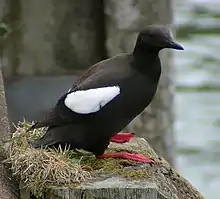
Order: Charadriiformes Family: Alcidae
Alcids are superficially similar to penguins due to their black-and-white colours, their upright posture, and some of their habits. However, they are not related to the penguins and differ in being able to fly. Auks live on the open sea, only deliberately coming ashore to nest.
| Common name | Binomial | Irish name | Status |
|---|---|---|---|
| Little auk | Alle alle | Foracha bheag | A |
| Thick-billed murre | Uria lomvia | Foracha brünnich | A R |
| Common murre | Uria aalge | Foracha | A |
| Razorbill | Alca torda | Crosán | A |
| Great auk | Pinguinus impennis | Foracha mhór | B |
| Black guillemot | Cepphus grylle | Foracha dhubh | A |
| Atlantic puffin | Fratercula arctica | Puifín | A |
Loons
_in_the_Morro_Bay.jpg.webp)
Order: Gaviiformes Family: Gaviidae
Loons, also known as divers, are a group of aquatic birds found in many parts of North America and northern Europe. They are the size of a large duck or small goose, which they somewhat resemble in shape when swimming, but to which they are completely unrelated.
| Common name | Binomial | Irish name | Status |
|---|---|---|---|
| Red-throated loon | Gavia stellata | Lóma rua | A |
| Black-throated loon | Gavia arctica | Lóma Artach | A |
| Pacific loon | Gavia pacifica | A R | |
| Common loon | Gavia immer | Lóma mór | A |
| Yellow-billed loon | Gavia adamsii | Lóma gobgheal | A R |
Austral storm petrels
Order: Procellariiformes Family: Oceanitidae
The storm petrels are the smallest seabirds, relatives of the petrels, feeding on planktonic crustaceans and small fish picked from the surface, typically while hovering. The flight is fluttering and sometimes bat-like. Until 2018, this family's species were included with the other storm petrels in family Hydrobatidae.
| Common name | Binomial | Irish name | Status |
|---|---|---|---|
| Wilson's storm petrel | Oceanites oceanicus | Guairdeall Wilson | A |
Albatrosses
Order: Procellariiformes Family: Diomedeidae
The albatrosses are among the largest of flying birds, and the great albatrosses from the genus Diomedea have the largest wingspans of any extant birds.
| Common name | Binomial | Irish name | Status |
|---|---|---|---|
| Black-browed albatross | Thalassarche melanophris | Albatras dú-mhalach | A R |
Northern storm petrels
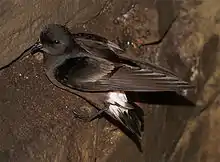
Order: Procellariiformes Family: Hydrobatidae
Though the members of this family are similar in many respects to the southern storm petrels, including their general appearance and habits, there are enough genetic differences to warrant their placement in a separate family.
| Common name | Binomial | Irish name | Status |
|---|---|---|---|
| European storm petrel | Hydrobates pelagicus | Guairdeall | A |
| Band-rumped storm petrel / Monteiro's storm petrel / Cape Verde storm petrel | Oceanodroma castro / Oceanodroma monteiroi / Oceanodroma jabejabe | B R (see note)[notes 1] | |
| Swinhoe's storm petrel | Oceanodroma monorhis | A R | |
| Leach's storm petrel | Oceanodroma leucorhoa | Guairdeall gabhlach | A |
Petrels, shearwaters, diving petrels
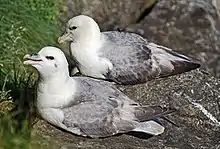
Order: Procellariiformes Family: Procellariidae
The procellariids are the main group of medium-sized "true petrels", characterised by united nostrils with medium septum and a long outer functional primary.
| Common name | Binomial | Irish name | Status |
|---|---|---|---|
| Northern fulmar | Fulmarus glacialis | Fulmaire | A |
| Zino's petrel / Fea's petrel / Desertas petrel | Pterodroma madeira / Pterodroma feae / Pterodroma deserta | Peadairín clúmhach Maidéarach / Peadairín clúmhach Fea / - | A |
| Cory's shearwater | Calonectris borealis | Cánóg Cory | A |
| Sooty shearwater | Ardenna griseus | Cánóg dhorcha | A |
| Great shearwater | Ardenna gravis | Cánóg mhór | A |
| Manx shearwater | Puffinus puffinus | Cánóg dhubh | A |
| Balearic shearwater | Puffinus mauretanicus | Cánóg Bhailéarach | A |
| Barolo shearwater | Puffinus baroli | Cánóg Barolo | A R |
| Bulwer's petrel | Bulweria bulwerii | Peadairín Bulwer | A R |
Storks
Order: Ciconiiformes Family: Ciconiidae
Storks are large, long-legged, long-necked, wading birds with long, stout bills. Storks are mute, but bill-clattering is an important mode of communication at the nest. Their nests can be large and may be reused for many years. Many species are migratory.
| Common name | Binomial | Irish name | Status |
|---|---|---|---|
| Black stork | Ciconia nigra | Storc dubh | A R |
| White stork | Ciconia ciconia | Storc bán | A |
Frigatebirds
Order: Suliformes Family: Fregatidae
Frigatebirds are large seabirds usually found over tropical oceans. They are large, black-and-white, or completely black, with long wings and deeply forked tails. The males have coloured inflatable throat pouches. They do not swim or walk and cannot take off from a flat surface. Having the largest wingspan-to-body-weight ratio of any bird, they are essentially aerial, able to stay aloft for more than a week.
| Common name | Binomial | Irish name | Status |
|---|---|---|---|
| Frigatebird species | Fregata sp. | Speiceas frigéid | A R |
Gannets, boobies
Order: Suliformes Family: Sulidae
The sulids comprise the gannets and boobies. Both groups are medium to large coastal seabirds that plunge-dive for fish.
| Common name | Binomial | Irish name | Status |
|---|---|---|---|
| Northern gannet | Morus bassanus | Gainead | A |
| Brown booby | Sula leucogaster | A |
Cormorants, shags
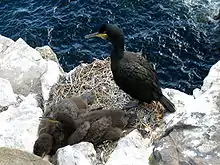
Order: Suliformes Family: Phalacrocoracidae
Phalacrocoracidae is a family of medium to large coastal, fish-eating seabirds that includes cormorants and shags. Plumage colouration varies, with the majority having mainly dark plumage, some species being black-and-white and a few being colourful.
| Common name | Binomial | Irish name | Status |
|---|---|---|---|
| Great cormorant | Phalacrocorax carbo | Broigheall | A |
| European shag | Phalacrocorax aristotelis | Seaga | A |
| Double-crested cormorant | Phalacrocorax auritus | Broigheall cluasach | A R |
Ibises and spoonbills

Order: Pelecaniformes Family: Threskiornithidae
Threskiornithidae is a family of large terrestrial and wading birds which includes the ibises and spoonbills. They have long, broad wings with 11 primary and about 20 secondary feathers. They are strong fliers and despite their size and weight, very capable soarers.
| Common name | Binomial | Irish name | Status |
|---|---|---|---|
| Glossy ibis | Plegadis falcinellus | Íbis niamhrach | A |
| Eurasian spoonbill | Platalea leucorodia | Corr leitheadach Eoráiseach | A |
Herons, bitterns
-_In_Breeding_plumage-actively_catching_prey_in_Kolkata_I_IMG_7990.jpg.webp)
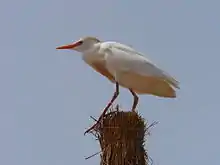
Order: Pelecaniformes Family: Ardeidae
The family Ardeidae contains the bitterns, herons, and egrets. Herons and egrets are medium to large wading birds with long necks and legs. Bitterns tend to be shorter-necked and more wary. Members of Ardeidae fly with their necks retracted, unlike other long-necked birds such as storks, ibises, and spoonbills.
| Common name | Binomial | Irish name | Status |
|---|---|---|---|
| Eurasian bittern | Botaurus stellaris | Bonnán | A |
| American bittern | Botaurus lentiginosus | Bonnán Meiriceánach | A R |
| Little bittern | Ixobrychus minutus | Bonnán beag | A |
| Black-crowned night heron | Nycticorax nycticorax | Corr oíche | A |
| Green heron | Butorides virescens | Corr ghormghlas | A R |
| Squacco heron | Ardeola ralloides | Corr scréachach | A |
| Western cattle egret | Bubulcus ibis | Éigrit eallaigh | A |
| Grey heron | Ardea cinerea | Corr réisc | A |
| Purple heron | Ardea purpurea | Corr chorcra | A |
| Great egret | Ardea alba | Éigrit mhór | A |
| Little blue heron | Egretta caerulea | Éigrit ghorm | A R |
| Little egret | Egretta garzetta | Éigrit bheag | A |
Ospreys
Order: Accipitriformes Family: Pandionidae
The family Pandionidae contains two species, the eastern and western ospreys. Ospreys are medium-large raptors that are specialist fish-eaters with a worldwide distribution.
| Common name | Binomial | Irish name | Status |
|---|---|---|---|
| Western osprey | Pandion haliaetus | Coirneach | A |
Kites, hawks, eagles
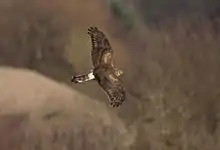
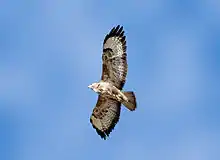
Order: Accipitriformes Family: Accipitridae
Accipitridae is a family of birds of prey which includes hawks, eagles, kites, harriers, and Old World vultures. These birds have powerful hooked beaks for tearing flesh from their prey, strong legs, powerful talons, and keen eyesight.
| Common name | Binomial | Irish name | Status |
|---|---|---|---|
| European honey buzzard | Pernis apivorus | Clamhán míl | A R |
| Griffon vulture | Gyps fulvus | Bultúr gríofa | B R |
| Greater spotted eagle | Clanga clanga | Iolar breac mór | B R |
| Golden eagle | Aquila chrysaetos | Iolar firéan | A R |
| Eurasian sparrowhawk | Accipiter nisus | Spioróg | A |
| Northern goshawk | Accipiter gentilis | Spioróg mhór | A R |
| Western marsh harrier | Circus aeruginosus | Cromán móna | A |
| Hen harrier | Circus cyaneus | Cromán na gcearc | A |
| Northern harrier | Circus hudsonius | A R | |
| Pallid harrier | Circus macrourus | Cromán bánlíoch | A R |
| Montagu's harrier | Circus pygargus | Cromán liath | A |
| Red kite | Milvus milvus | Cúr rua | A |
| Black kite | Milvus migrans | Cúr dubh | A R |
| White-tailed eagle | Haliaeetus albicilla | Iolar mara | A R |
| Bald eagle | Haliaeetus leucocephalus | Iolar mhaol | A R |
| Rough-legged buzzard | Buteo lagopus | Clamhán lópach | A R |
| Common buzzard | Buteo buteo | Clamhán | A |
Barn owls
Order: Strigiformes Family: Tytonidae
Barn owls are medium to large owls with large heads and characteristic heart-shaped faces. They have long strong legs with powerful talons.
| Common name | Binomial | Irish name | Status |
|---|---|---|---|
| Western barn owl | Tyto alba | Scréachóg reilige | A |
Owls
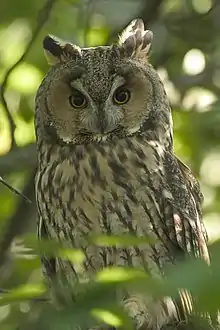
Order: Strigiformes Family: Strigidae
The typical owls are small to large solitary nocturnal birds of prey. They have large forward-facing eyes and ears, a hawk-like beak, and a conspicuous circle of feathers around each eye called a facial disk.
| Common name | Binomial | Irish name | Status |
|---|---|---|---|
| Eurasian scops owl | Otus scops | Ulchabhán scopach Eoráiseach | A R |
| Snowy owl | Bubo scandiacus | Ulchabhán sneachtúil | A |
| Little owl | Athene noctua | Ulchabhán beag | A R |
| Long-eared owl | Asio otus | Ceann cait | A |
| Short-eared owl | Asio flammeus | Ulchabhán réisc | A |
Hoopoes
Order: Bucerotiformes Family: Upupidae
Hoopoes have black, white, and orangey-pink colouring with a large erectile crest on their head.
| Common name | Binomial | Irish name | Status |
|---|---|---|---|
| Eurasian hoopoe | Upupa epops | Húpú | A |
Rollers
Order: Coraciiformes Family: Coraciidae
Rollers resemble crows in size and build, but are more closely related to the kingfishers and bee-eaters. They share the colourful appearance of those groups with blues and browns predominating. The two inner front toes are connected, but the outer toe is not.
| Common name | Binomial | Irish name | Status |
|---|---|---|---|
| European roller | Coracias garrulus | Rollóir Eorpach | A R |
Kingfishers
.jpg.webp)
Order: Coraciiformes Family: Alcedinidae
Kingfishers are medium-sized birds with large heads, long pointed bills, short legs, and stubby tails.
| Common name | Binomial | Irish name | Status |
|---|---|---|---|
| Common kingfisher | Alcedo atthis | Cruidín | A |
| Belted kingfisher | Megaceryle alcyon | Cruidín creasa | A R |
Bee-eaters
Order: Coraciiformes Family: Meropidae
The bee-eaters are a family of near passerine birds found mostly in Africa, but others occur in southern Europe, Madagascar, Australia, and New Guinea. They are characterised by richly coloured plumage, slender bodies, and usually elongated central tail feathers. All are colourful and have long downturned bills and pointed wings, which give them a swallow-like appearance when seen from afar.
| Common name | Binomial | Irish name | Status |
|---|---|---|---|
| European bee-eater | Merops apiaster | Beachadóir Eorpach | A |
Woodpeckers
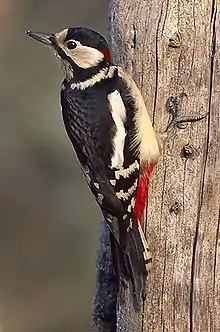
Order: Piciformes Family: Picidae
Woodpeckers are small to medium-sized birds with chisel-like beaks, short legs, stiff tails, and long tongues used for capturing insects. Some species have feet with two toes pointing forward and two backward, while several species have only three toes. Many woodpeckers have the habit of tapping noisily on tree trunks with their beaks. Great spotted woodpecker has started breeding in recent years.[5]
| Common name | Binomial | Irish name | Status |
|---|---|---|---|
| Eurasian wryneck | Jynx torquilla | Cam-mhuin | A |
| Yellow-bellied sapsucker | Sphyrapicus varius | Súdhiúlaí tarrbhuí | A R |
| Great spotted woodpecker | Dendrocopos major | Mórchnagaire breac | A |
| Eurasian green woodpecker | Picus viridis | Cnagaire glas | B R |
Caracaras, falcons
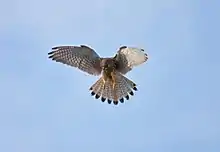
Order: Falconiformes Family: Falconidae
Falconidae is a family of diurnal birds of prey. They differ from hawks, eagles, and kites in that they kill with their beaks instead of their talons.
| Common name | Binomial | Irish name | Status |
|---|---|---|---|
| Lesser kestrel | Falco naumanni | Mionphocaire gaoithe | B R |
| Common kestrel | Falco tinnunculus | Pocaire gaoithe | A |
| Red-footed falcon | Falco vespertinus | Fabhcún cosdearg | A |
| Merlin | Falco columbarius | Meirliún | A |
| Eurasian hobby | Falco subbuteo | Fabhcún coille | A |
| Gyrfalcon | Falco rusticolus | Fabhcún mór | A R |
| Peregrine falcon | Falco peregrinus | Fabhcún gorm | A |
Tyrant flycatchers, calyptura
Order: Passeriformes Family: Tyrannidae
Tyrant flycatchers occur throughout North and South America. They superficially resemble the Old World flycatchers, but are more robust and have stronger bills. They do not have the sophisticated vocal capabilities of the songbirds. Most, but not all, are rather plain. As the name implies, most are insectivorous.
| Common name | Binomial | Irish name | Status |
|---|---|---|---|
| Eastern kingbird | Tyrannus tyrannus | A R |
Shrikes
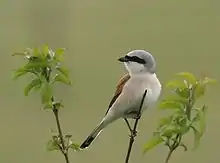
Order: Passeriformes Family: Laniidae
Shrikes are passerine birds known for their habit of catching other birds and small animals and impaling the uneaten portions of their bodies on thorns. A shrike's beak is hooked, like that of a typical bird of prey.
| Common name | Binomial | Irish name | Status |
|---|---|---|---|
| Brown shrike | Lanius cristatus | Scréachán donn | A R |
| Red-backed shrike | Lanius collurio | Scréachán droimrua | A |
| Isabelline shrike | Lanius isabellinus | A R | |
| Lesser grey shrike | Lanius minor | Mionscréachán liath | A R |
| Great grey shrike | Lanius excubitor | Mórscréachán liath | A R |
| Woodchat shrike | Lanius senator | Scréachán coille | A |
Vireos, greenlets, shrike-babblers
Order: Passeriformes Family: Vireonidae
The vireos are a group of small to medium-sized passerine birds restricted to the New World. They are typically greenish in colour and resemble New World warblers apart from their heavier bills.
| Common name | Binomial | Irish name | Status |
|---|---|---|---|
| Philadelphia vireo | Vireo philadelphicus | Glaséan Philadelphia | A R |
| Red-eyed vireo | Vireo olivaceus | Glaséan súildearg | A R |
Figbirds, orioles, turnagra
Order: Passeriformes Family: Oriolidae
The Old World orioles are colourful passerine birds. They are not related to the New World orioles.
| Common name | Binomial | Irish name | Status |
|---|---|---|---|
| Eurasian golden oriole | Oriolus oriolus | Óiréal órga | A |
Crows, jays
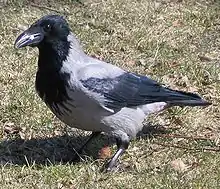
Order: Passeriformes Family: Corvidae
The family Corvidae includes crows, ravens, jackdaws, jays, choughs, magpies, treepies, nutcrackers, and ground jays. Corvids are above average in size among the Passeriformes, and some of the larger species show high levels of intelligence.
| Common name | Binomial | Irish name | Status |
|---|---|---|---|
| Eurasian jay | Garrulus glandarius | Scréachóg / scéachóg choille | A |
| Eurasian magpie | Pica pica | Snag breac | A |
| Red-billed chough | Pyrrhocorax pyrrhocorax | Cág cosdearg | A |
| Eurasian jackdaw | Corvus monedula | Cág | A |
| Rook | Corvus frugilegus | Rúcach | A |
| Carrion crow | Corvus corone | Caróg dhubh | A |
| Hooded crow | Corvus cornix | Caróg liath | A |
| Northern raven | Corvus corax | Fiach dubh | A |
Waxwings
Order: Passeriformes Family: Bombycillidae
The waxwings are a group of birds with soft silky plumage and unique red tips to some of the wing feathers. In the Bohemian and cedar waxwings, these tips look like sealing wax and give the group its name. These are arboreal birds of northern forests. They live on insects in summer and berries in winter.
| Common name | Binomial | Irish name | Status |
|---|---|---|---|
| Bohemian waxwing | Bombycilla garrulus | Síodeiteach | A |
| Cedar waxwing | Bombycilla cedrorum | A R |
Tits, chickadees
_on_line.jpeg.webp)
Order: Passeriformes Family: Paridae
The Paridae are mainly small stocky woodland species with short stout bills. Some have crests. They are adaptable birds, with a mixed diet including seeds and insects.
| Common name | Binomial | Irish name | Status |
|---|---|---|---|
| Coal tit | Periparus ater | Meantán dubh | A |
| Marsh tit | Poecile palustris | Meantán lathaí | A R |
| Eurasian blue tit | Cyanistes caeruleus | Meantán gorm | A |
| Great tit | Parus major | Meantán mór | A |
Bearded reedling
Order: Passeriformes Family: Panuridae
This species, the only one in its family, is found in reed beds throughout temperate Europe and Asia.
| Common name | Binomial | Irish name | Status |
|---|---|---|---|
| Bearded reedling | Panurus biarmicus | Meantán croiméalach | A |
Larks
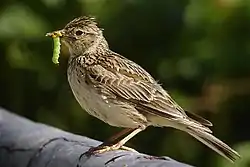
Order: Passeriformes Family: Alaudidae
Larks are small terrestrial birds with often extravagant songs and display flights. Most larks are fairly dull in appearance. Their food is insects and seeds.
| Common name | Binomial | Irish name | Status |
|---|---|---|---|
| Wood lark | Lullula arborea | Fuiseog choille | A R |
| Eurasian skylark | Alauda arvensis | Fuiseog | A |
| Horned lark | Eremophila alpestris | Fuiseog adharcach | A |
| Greater short-toed lark | Calandrella brachydactyla | Fuiseog ladharghearr | A |
Swallows, martins
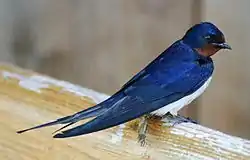
Order: Passeriformes Family: Hirundinidae
The family Hirundinidae is adapted to aerial feeding. They have a slender streamlined body, long pointed wings, and a short bill with a wide gape. The feet are adapted to perching rather than walking, and the front toes are partially joined at the base.
| Common name | Binomial | Irish name | Status |
|---|---|---|---|
| Sand martin | Riparia riparia | Gabhlán gainimh | A |
| Barn swallow | Hirundo rustica | Fáinleog | A |
| Common house martin | Delichon urbicum | Gabhlán binne | A |
| Red-rumped swallow | Cecropis daurica | Fáinleog ruaphrompach | A |
| American cliff swallow | Petrochelidon pyrrhonota | Fáinleog aille Mheiriceánach | A R |
Streaked scrub warbler
Order: Passeriformes Family: Scotocercidae
The members of this family are found throughout Africa, Asia, and Polynesia. This species is the only one found regularly in Europe.
| Common name | Binomial | Irish name | Status |
|---|---|---|---|
| Cetti's warbler | Cettia cetti | Ceolaire Cetti | A R |
Bushtits
.jpg.webp)
Order: Passeriformes Family: Aegithalidae
Long-tailed tits are a group of small passerine birds with medium to long tails. They make woven bag nests in trees. Most eat a mixed diet which includes insects.
| Common name | Binomial | Irish name | Status |
|---|---|---|---|
| Long-tailed tit | Aegithalos caudatus | Meantán earrfhada | A |
Leaf warblers and allies
Order: Passeriformes Family: Phylloscopidae
Leaf warblers are a family of small insectivorous birds found mostly in Eurasia and ranging into Wallacea and Africa. The species are of various sizes, often green-plumaged above and yellow below, or more subdued with greyish-green to greyish-brown colors.
| Common name | Binomial | Irish name | Status |
|---|---|---|---|
| Wood warbler | Phylloscopus sibilatrix | Ceolaire coille | A |
| Western Bonelli's warbler | Phylloscopus bonelli | Ceolaire Bonelli | A R |
| Hume's leaf warbler | Phylloscopus humei | Ceolaire Hume | A R |
| Yellow-browed warbler | Phylloscopus inornatus | Ceolaire buímhalach | A |
| Pallas's leaf warbler | Phylloscopus proregulus | Ceolaire Pallas | A |
| Radde's warbler | Phylloscopus schwarzi | Ceolaire Radde | A R |
| Dusky warbler | Phylloscopus fuscatus | Ceolaire breacdhorcha | A R |
| Willow warbler | Phylloscopus trochilus | Ceolaire sailí | A |
| Common chiffchaff | Phylloscopus collybita | Tiuf-teaf | A |
| Iberian chiffchaff | Phylloscopus ibericus | Tiuf-teaf Ibéarach | A R |
| Greenish warbler | Phylloscopus trochiloides | Ceolaire scothghlas | A |
| Arctic warbler | Phylloscopus borealis | Ceolaire Artach | A R |
Reed warblers and allies
Order: Passeriformes Family: Acrocephalidae
The members of this family are usually rather large for "warblers". Most are rather plain olivaceous brown above with much yellow to beige below. They are usually found in open woodland, reedbeds, or tall grass. The family occurs mostly in southern to western Eurasia and surroundings, but it also ranges far into the Pacific, with some species in Africa.
| Common name | Binomial | Irish name | Status |
|---|---|---|---|
| Great reed warbler | Acrocephalus arundinaceus | Ceolaire giolcaí mór | A R |
| Aquatic warbler | Acrocephalus paludicola | Ceolaire uisce | A R |
| Sedge warbler | Acrocephalus schoenobaenus | Ceolaire cíbe | A |
| Paddyfield warbler | Acrocephalus agricola | Ceolaire gort ríse | A R |
| Blyth's reed warbler | Acrocephalus dumetorum | Ceolaire Blyth | A R |
| Eurasian reed warbler | Acrocephalus scirpaceus | Ceolaire giolcaí | A |
| Marsh warbler | Acrocephalus palustris | Ceolaire corraigh | A R |
| Booted warbler | Iduna caligata | Ceolaire cuaráin | A R |
| Sykes's warbler | Iduna rama | Ceolaire Syke | A R |
| Eastern olivaceous warbler | Iduna pallida | Ceolaire bánlíoch | A R |
| Melodious warbler | Hippolais polyglotta | Ceolaire binn | A |
| Icterine warbler | Hippolais icterina | Ceolaire ictireach | A |
Grassbirds and allies
Order: Passeriformes Family: Locustellidae
Locustellidae are a family of small insectivorous songbirds found mainly in Eurasia, Africa, and the Australian region. They are smallish birds with tails that are usually long and pointed, and tend to be drab brownish or buffy all over.
| Common name | Binomial | Irish name | Status |
|---|---|---|---|
| Pallas's grasshopper warbler | Helopsaltes certhiola | Ceolaire casarnaí Pallas | A R |
| Savi's warbler | Locustella luscinioides | Ceolaire Savi | A R |
| Common grasshopper warbler | Locustella naevia | Ceolaire casarnaí | A |
Cisticolas and allies
Order: Passeriformes Family: Cisticolidae
The Cisticolidae are warblers found mainly in warmer southern regions of the Old World. They are generally very small birds of drab brown or grey appearance found in open country such as grassland or scrub.
| Common name | Binomial | Irish name | Status |
|---|---|---|---|
| Zitting cisticola | Cisticola juncidis | Ceolaire feanearrach | A R |
Sylviid babblers

Order: Passeriformes Family: Sylviidae
The family Sylviidae is a group of small insectivorous passerine birds. They mainly occur as breeding species, as another common name (Old World warblers) implies, in Europe, Asia, and, to a lesser extent, Africa. Most are of generally undistinguished appearance, but many have distinctive songs.
| Common name | Binomial | Irish name | Status |
|---|---|---|---|
| Eurasian blackcap | Sylvia atricapilla | Caipín dubh | A |
| Garden warbler | Sylvia borin | Ceolaire garraí | A |
| Barred warbler | Curruca nisoria | Ceolaire barrach | A |
| Lesser whitethroat | Curruca curruca | Gilphíb bheag | A |
| Sardinian warbler | Curruca melanocephala | Ceolaire Sairdíneach | A R |
| Western subalpine warbler / Eastern subalpine warbler | Curruca iberiae / Curruca cantillans | Ceolaire fo-Alpach | A |
| Common whitethroat | Curruca communis | Gilbhíb mór | A |
| Dartford warbler | Curruca undata | Ceolaire fraoigh | A R |
Goldcrests, kinglets
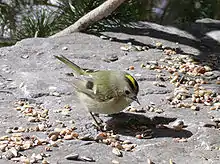
Order: Passeriformes Family: Regulidae
The kinglets, also called crests, are a small group of birds which were sometimes included in the Old World warblers, family Sylviidae.
| Common name | Binomial | Irish name | Status |
|---|---|---|---|
| Common firecrest | Regulus ignicapillus | Lasairchíor | A |
| Goldcrest | Regulus regulus | Cíorbhuí | A |
| Ruby-crowned kinglet | Regulus calendula | A R |
Wrens
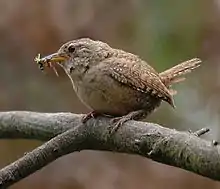
Order: Passeriformes Family: Troglodytidae
The wrens are mainly small and inconspicuous except for their loud songs. These birds have short wings and thin down-turned bills. Several species often hold their tails upright. All are insectivorous.
| Common name | Binomial | Irish name | Status |
|---|---|---|---|
| Eurasian wren | Troglodytes troglodytes | Dreolín | A |
Treecreepers
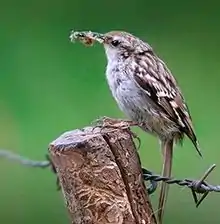
Order: Passeriformes Family: Certhiidae
Treecreepers are small woodland birds, brown above and white below. They have thin pointed down-curved bills, which they use to extricate insects from bark. They have stiff tail feathers, like woodpeckers, which they use to support themselves on vertical trees.
| Common name | Binomial | Irish name | Status |
|---|---|---|---|
| Eurasian treecreeper | Certhia familiaris | Snag coiteann | A |
Mockingbirds, thrashers
Order: Passeriformes Family: Mimidae
The mimids are a family of passerine birds that includes thrashers, mockingbirds, tremblers, and the New World catbirds. These birds are notable for their vocalizations, especially their ability to mimic a wide variety of birds and other sounds heard outdoors. Their colouring tends towards dull-greys and browns.
| Common name | Binomial | Irish name | Status |
|---|---|---|---|
| Grey catbird | Dumetella carolinensis | Catéan liath | A R |
Starlings, rhabdornis
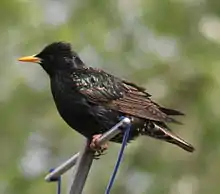
Order: Passeriformes Family: Sturnidae
Starlings are small to medium-sized passerine birds. Their flight is strong and direct and they are very gregarious. Their preferred habitat is fairly open country. They eat insects and fruit. Plumage is typically dark with a metallic sheen.
| Common name | Binomial | Irish name | Status |
|---|---|---|---|
| Rosy starling | Pastor roseus | Druid rósach | A |
| European starling | Sturnus vulgaris | Druid | A |
Thrushes
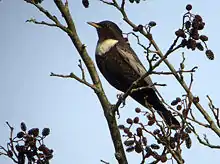
Order: Passeriformes Family: Turdidae
The thrushes are a group of passerine birds that occur mainly in the Old World. They are plump, soft plumaged, small to medium-sized insectivores or sometimes omnivores, often feeding on the ground. Many have attractive songs.
| Common name | Binomial | Irish name | Status |
|---|---|---|---|
| Siberian thrush | Geokichla sibirica | Smólach Sibéarach | A R |
| White's thrush | Zoothera aurea | Smólach White | A R |
| Veery | Catharus fuscescens | A | |
| Grey-cheeked thrush | Catharus minimus | Smólach glasleicneach | A R |
| Swainson's thrush | Catharus ustulatus | Smólach Swainson | A R |
| Hermit thrush | Catharus guttatus | Smólach ceallaigh | A R |
| Ring ouzel | Turdus torquatus | Lon creige | A |
| Eurasian blackbird | Turdus merula | Lon dubh | A |
| Fieldfare | Turdus pilaris | Sacán | A |
| Redwing | Turdus iliacus | Deargán sneachta | A |
| Song thrush | Turdus philomelos | Smólach ceoil | A |
| Mistle thrush | Turdus viscivorus | Smólach mór | A |
| American robin | Turdus migratorius | Spideog | A R |
Chats, Old World flycatchers
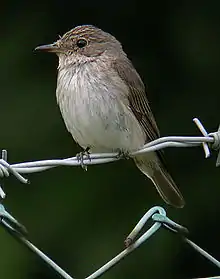
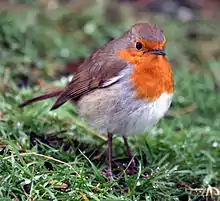
Order: Passeriformes Family: Muscicapidae
Old World flycatchers are a large family of mainly small arboreal insectivores. The appearance of these birds is highly varied, but they mostly have weak songs and harsh calls.
| Common name | Binomial | Irish name | Status |
|---|---|---|---|
| Rufous-tailed scrub robin | Cercotrichas galactotes | Torspideog ruadhonn | A R |
| Spotted flycatcher | Muscicapa striata | Cuilire liath | A |
| European robin | Erithacus rubecula | Spideog | A |
| Bluethroat | Luscinia svecica | Gormphíb | A |
| Thrush nightingale | Luscinia luscinia | Filiméala smólaigh | A R |
| Common nightingale | Luscinia megarhynchos | Filiméala | A |
| Red-flanked bluetail | Tarsiger cyanurus | An t-earrghorm rua-chliathánach | A R |
| Taiga flycatcher | Ficedula albicilla | A | |
| Red-breasted flycatcher | Ficedula parva | Cuilire broinnrua | A |
| European pied flycatcher | Ficedula hypoleuca | Cuilire alabhreac | A |
| Collared flycatcher | Ficedula albicollis | A R | |
| Black redstart | Phoenicurus ochruros | Earrdheargán dubh | A |
| Common redstart | Phoenicurus phoenicurus | Earrdheargán | A |
| Common rock thrush | Monticola saxatilis | Smólach aille | A R |
| Whinchat | Saxicola rubetra | Caislín aitinn | A |
| European stonechat | Saxicola rubicola | Caislín cloch | A |
| Siberian stonechat | Saxicola maurus | A R | |
| Northern wheatear | Oenanthe oenanthe | Clochrán | A |
| Isabelline wheatear | Oenanthe isabellina | Clochrán gainimh | A R |
| Desert wheatear | Oenanthe deserti | Clochrán fásaigh | A R |
| Western black-eared wheatear | Oenanthe hispanica | Clochrán cluasdubh | A R |
| Pied wheatear | Oenanthe pleschanka | Clochrán alabhreac | A |
| Black wheatear / White-crowned wheatear | Oenanthe leucura / Oenanthe leucopyga | Clochrán dubh / - | A R |
Dippers
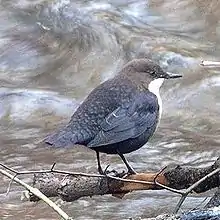
Order: Passeriformes Family: Cinclidae
Dippers are a group of perching birds whose habitat includes aquatic environments in the Americas, Europe, and Asia. They are named for their bobbing or dipping movements.
| Common name | Binomial | Irish name | Status |
|---|---|---|---|
| White-throated dipper | Cinclus cinclus | Gabha dubh | A |
Old World sparrows, snowfinches
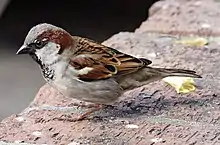
Order: Passeriformes Family: Passeridae
Sparrows are small passerine birds. In general, sparrows tend to be small, plump, brown or grey birds with short tails and short powerful beaks. Sparrows are seed eaters, but they also consume small insects.
| Common name | Binomial | Irish name | Status |
|---|---|---|---|
| House sparrow | Passer domesticus | Gealbhan binne | A |
| Eurasian tree sparrow | Passer montanus | Gealbhan crainn | A |
Accentors
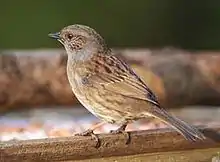
Order: Passeriformes Family: Prunellidae
The accentors are the only bird family which is completely endemic to the Palearctic. They are small, fairly drab species superficially similar to Old World sparrows.
| Common name | Binomial | Irish name | Status |
|---|---|---|---|
| Dunnock | Prunella modularis | Donnóg | A |
Wagtails, pipits

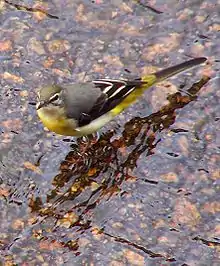
Order: Passeriformes Family: Motacillidae
Motacillidae is a family of small passerine birds with medium to long tails. They include the wagtails, longclaws and pipits. They are slender, ground feeding insectivores of open country.
Two subspecies of white wagtail occur in Ireland:[6]
- Motacilla alba yarrelli, "pied wagtail", a common breeding resident.
- M. a. alba, nominate subspecies occurring as a migrant.
| Common name | Binomial | Irish name | Status |
|---|---|---|---|
| Western yellow wagtail | Motacilla flava | Glasóg bhuí | A |
| Eastern yellow wagtail | Motacilla tschutschensis | A | |
| Citrine wagtail | Motacilla citreola | Glasóg chiotrónach | A |
| Grey wagtail | Motacilla cinerea | Glasóg liath | A |
| White wagtail | Motacilla alba | Glasóg shráide / glasóg bhán | A |
| Richard's pipit | Anthus richardi | Riabhóg Richard | A |
| Tawny pipit | Anthus campestris | Riabhóg dhonn | A |
| Meadow pipit | Anthus pratensis | Riabhóg mhóna | A |
| Tree pipit | Anthus trivialis | Riabhóg choille | A |
| Olive-backed pipit | Anthus hodgsoni | Riabhóg dhroimghlas | A R |
| Pechora pipit | Anthus gustavi | Riabhóg Pechora | A R |
| Red-throated pipit | Anthus cervinus | Riabhóg phíbrua | A |
| Buff-bellied pipit | Anthus rubescens | Riabhóg Mheiriceánach | A R |
| Water pipit | Anthus spinoletta | Riabhóg uisce | A |
| Eurasian rock pipit | Anthus petrosus | Riabhóg chladaigh | A |
Finches, euphonias

Order: Passeriformes Family: Fringillidae
Finches are seed-eating passerine birds that are small to moderately large and have a strong beak, usually conical and in some species very large. All have twelve tail feathers and nine primaries. These birds have a bouncing flight with alternating bouts of flapping and gliding on closed wings, and most sing well.
| Common name | Binomial | Irish name | Status |
|---|---|---|---|
| Common chaffinch | Fringilla coelebs | Rí rua | A |
| Brambling | Fringilla montifringilla | Breacán | A |
| Hawfinch | Coccothraustes coccothraustes | Glasán gobmhór | A |
| Eurasian bullfinch | Pyrrhula pyrrhula | Corcrán coille | A |
| Common rosefinch | Carpodacus erythrinus | Rósghlasán coiteann | A |
| European greenfinch | Chloris chloris | Glasán darach | A |
| Twite | Linaria flavirostris | Gleoiseach sléibhe | A |
| Common linnet | Linaria cannabina | Gleoiseach | A |
| Common redpoll | Acanthis flammea | Deargéadan | A |
| Lesser redpoll | Acanthis cabaret | Deargéadan beag | A |
| Arctic redpoll | Acanthis hornemanni | Deargéadan Artach | A R |
| Red crossbill | Loxia curvirostra | Crosghob rua | A |
| Two-barred crossbill | Loxia leucoptera | Crosghob báneiteach | A R |
| European goldfinch | Carduelis carduelis | Lasair choille | A |
| European serin | Serinus serinus | Seirín | A R |
| Eurasian siskin | Spinus spinus | Siscín | A |
Longspurs, snow buntings
Order: Passeriformes Family: Calcariidae
The Calcariidae are a group of passerine birds that had been traditionally grouped with the New World sparrows, but differ in a number of respects and are usually found in open grassy areas.
| Common name | Binomial | Irish name | Status |
|---|---|---|---|
| Lapland longspur | Calcarius lapponicus | Gealóg Laplannach | A |
| Snow bunting | Plectrophenax nivalis | Gealóg shneachta | A |
Buntings

Order: Passeriformes Family: Emberizidae
Emberizidae is a family of passerine birds containing a single genus. Until 2017, the New World sparrows (Passerellidae) were also considered part of this family.
| Common name | Binomial | Irish name | Status |
|---|---|---|---|
| Black-headed bunting | Emberiza melanocephala | Gealóg cheanndubh | A R |
| Corn bunting | Emberiza calandra | Gealóg bhuachair | A |
| Yellowhammer | Emberiza citrinella | Buíóg | A |
| Pine bunting | Emberiza leucocephalos | Gealóg phéine | A R |
| Ortolan bunting | Emberiza hortulana | Gealóg gharraí | A |
| Cirl bunting | Emberiza cirlus | Cirlghealóg | A R |
| Little bunting | Emberiza pusilla | Gealóg bheag | A |
| Rustic bunting | Emberiza rustica | Gealóg thuathúil | A |
| Yellow-breasted bunting | Emberiza aureola | Gealóg bhroinnbhuí | A R |
| Common reed bunting | Emberiza schoeniclus | Gealóg ghiolcaí | A |
New World sparrows
Order: Passeriformes Family: Passerellidae
Until 2017, these species were considered part of the family Emberizidae. Most of the species are known as sparrows, but these birds are not closely related to the Old World sparrows which are in the family Passeridae. Many of these have distinctive head patterns.
| Common name | Binomial | Irish name | Status |
|---|---|---|---|
| Red fox sparrow | Passerella iliaca | Gealbhan sionnaigh | A R |
| Dark-eyed junco | Junco hyemalis | Luachairín shúildubh | A R |
| White-crowned sparrow | Zonotrichia leucophrys | Gealbhan bánchorónach | A R |
| White-throated sparrow | Zonotrichia albicollis | Gealbhan píbgheal | A R |
Oropendolas, orioles, blackbirds
Order: Passeriformes Family: Icteridae
The icterids are a group of small to medium-sized, often colourful, passerine birds restricted to the New World and include the grackles, New World blackbirds, and New World orioles. Most species have black as the predominant plumage colour, often enlivened by yellow, orange, or red.
| Common name | Binomial | Irish name | Status |
|---|---|---|---|
| Bobolink | Dolichonyx oryzivorus | Bobóilinc | A R |
| Baltimore oriole | Icterus galbula | Óiréal tuaisceartach | A R |
New World warblers
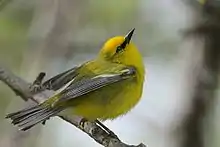
Order: Passeriformes Family: Parulidae
The New World warblers are a group of small, often colourful, passerine birds restricted to the New World. Most are arboreal, but some are terrestrial. Most members of this family are insectivores.
| Common name | Binomial | Irish name | Status |
|---|---|---|---|
| Ovenbird | Seiurus aurocapilla | A R | |
| Northern waterthrush | Parkesia noveboracensis | Smólach uisce tuaisceartach | A R |
| Blue-winged warbler | Vermivora cyanoptera | Ceolaire gormeiteach | A R |
| Black-and-white warbler | Mniotilta varia | Ceolaire dubh is bán | A R |
| Common yellowthroat | Geothlypis trichas | Buíphíb choiteann | A R |
| American redstart | Setophaga ruticilla | Earrdheargán Meiriceánach | A R |
| Northern parula | Setophaga americana | A R | |
| American yellow warbler | Setophaga aestiva | A R | |
| Blackpoll warbler | Setophaga striata | Ceolaire dubhéadanach | A R |
| Myrtle warbler | Setophaga coronata | Ceolaire buíphrompach | A R |
| Canada warbler | Cardellina canadensis | Ceolaire Ceanadach | A R |
| Wilson's warbler | Cardellina pusilla | A R |
Cardinals and allies
Order: Passeriformes Family: Cardinalidae
The cardinals are a family of robust, seed-eating birds with strong bills. They are typically associated with open woodland. The sexes usually have distinct plumages.
| Common name | Binomial | Irish name | Status |
|---|---|---|---|
| Scarlet tanager | Piranga olivacea | Tanagair scarlóideach | A R |
| Rose-breasted grosbeak | Pheucticus ludovicianus | Gobach mór broinnrósach | A R |
| Indigo bunting | Passerina cyanea | Gealóg phlúiríneach | A R |
Notes
- "Following the split of Madeiran Storm-petrel as three species, the Irish record at Blackrock Lighthouse, Mayo in October 1931, is currently under review by the IRBC."
References
- "Irish List covering the whole of Ireland on 31st Dec 2019" (PDF). Irish Rare Birds Committee. 31 December 2019. Retrieved 16 July 2020.
- Gill, F.; Donsker, D.; Rasmussen, P. (July 2020). "IOC World Bird List (v 10.2)". Retrieved 15 July 2020.
- "The National Terminology Database for Irish". téarma.ie.
- ""Mallard"". téarma.ie. The National Terminology Database for Irish.
- "Have you heard Ireland's drumming woodpeckers?". RTÉ. 3 April 2018. Retrieved 21 February 2020.
- "White Wagtail". Birds of the World. The Cornell Lab or Ornithology. doi:10.2173/bow.whiwag.01. Retrieved 19 September 2020.
- Dempsey, Eric & O'Clery, Michael (1995). Pocket Guide to the Common Birds of Ireland. Gill & Macmillan Ltd, Dublin.
- Dempsey, Eric & O'Clery, Michael (2007). Finding Birds in Ireland: The Complete Guide. Gill & Macmillan Ltd, Dublin.
See also
External links
| Wikimedia Commons has media related to Aves. |
- National Biodiversity Network Distribution Maps (Ongoing)
- Oiseaux Ireland page. Many photos. Not all species.
- Irish Birding Latest sightings.
- Irish Rare Birds Committee
- NIBWA Northern Ireland Bird watchers Association.
- NIOC Northern Ireland Ornithologists Club. Excellent photographs
- Bird Guides Irish list, county lists, latest sightings and photos.
- RSPB Royal Society for the Protection of Birds A-Z
